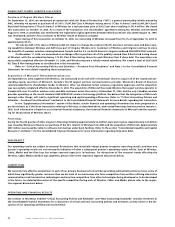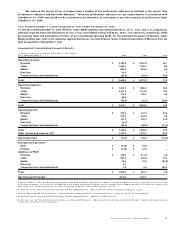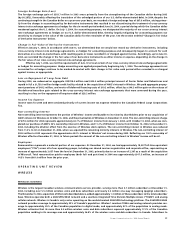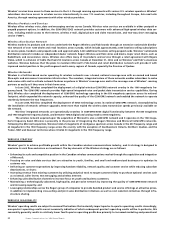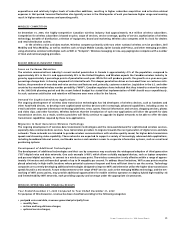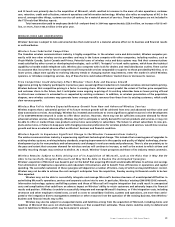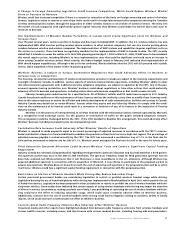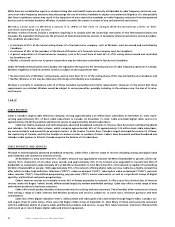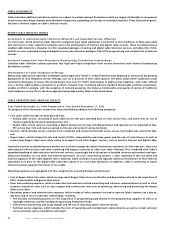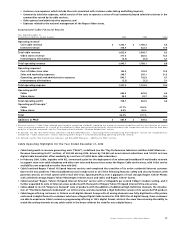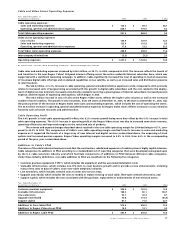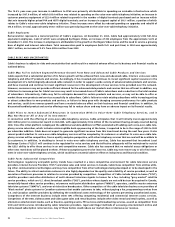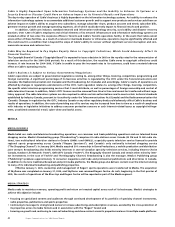Rogers 2004 Annual Report Download - page 32
Download and view the complete annual report
Please find page 32 of the 2004 Rogers annual report below. You can navigate through the pages in the report by either clicking on the pages listed below, or by using the keyword search tool below to find specific information within the annual report.
30 Rogers Communications Inc. 2004 Annual Report
In 2000, Microcell obtained licences in the 2.5 MHz or MCS spectrum. This spectrum was acquired in a competitive licencing
process and accordingly is subject to rollout commitments and commitments to fund a “Learning Plan”. If Wireless is unable to roll out
the service in accordance with Industry Canada requirements, the MCS licences could be revoked by Industry Canada.
Wireless’ telecommunications network and portions of the telecommunications network operated by Microcell are based on the
network equipment and infrastructure supplied by different telecommunications equipment vendors. This could materially adversely
affect or delay the network integration plans and increase Wireless’ capital and operating costs.
There is No Guarantee that Wireless’ Third Generation Technology Will Be Competitive or Compatible with Other
Technologies
The deployment of EDGE technology may not be competitive or compatible with other technologies. Wireless also expects to develop a
High-Speed Downlink Packet Access (“HSDPA”) technology-based network that will supplement its GSM/GPRS/EDGE networks. While
Wireless and other U.S. and international operators have selected these technologies as an evolutionary step from its current and
future networks, there are other competing technologies that are being developed and implemented in both Canada and other parts of
the world. None of the competing technologies are directly compatible with each other. If the third generation technology that gains
the most widespread acceptance is not compatible with Wireless’ networks, competing services based on such alternative technology
may be preferable to subscribers and Wireless’ business may be materially adversely affected.
Wireless May Encounter Difficulties with Respect to the Continued Development of Third Generation Network
Technology
Wireless is currently pursuing a strategy to transition its technology network to third generation technology with enhanced digital
voice and data transmission capabilities. In order to implement this transition successfully:
• Network technology developers must complete the refinement of third generation network technologies, specifically HSDPA, network
technologies; and
• Wireless must complete the implementation of the fixed network infrastructure to support its third generation technologies, which
will include design and installation of upgrades to its existing network equipment.
Wireless cannot be certain that these steps will be completed in the time frame or at the cost anticipated. Wireless’ third generation
technology network will rely, in many instances, on new and unproven technology. As with any new technology, there is a risk that the
new technology Wireless has chosen for its network will not perform as expected, that it may be unable to integrate the new technol-
ogy with its current technology and that it may be unable to deliver next generation services in a cost-effective manner. The occurrence
of any of these difficulties could delay the development of its network, which could materially adversely affect Wireless’ business.
Wireless is Highly Dependent Upon its Information Technology Systems and the Inability to Enhance its Systems or
a Security Breach or Disaster Could Have an Adverse Impact on its Financial Results and Operations
The day-to-day operation of Wireless’ business is highly dependent on its information technology systems. An inability to enhance
information technology systems to accommodate additional customer growth and support new products and services could have an
adverse impact on Wireless’ ability to acquire new subscribers, manage subscriber churn, produce accurate and timely subscriber bills,
generate revenue growth and manage operating expenses, all of which could adversely impact its financial results and position.
In connection with its acquisition of Microcell, Wireless intends to integrate its information technology systems with those of Microcell
and this integration could result in unexpected costs and complications that could have an adverse impact on Wireless’ ability to retain
customers, which could materially adversely impact its financial results and position.
In addition, Wireless uses industry standard network and information technology security, survivability and disaster recovery
practices. Approximately 1,500 of Wireless’ employees and critical elements of the network infrastructure and information technology
systems are located at the corporate offices in Toronto. In the event that Wireless cannot access these facilities, as a result of a natural
or manmade disaster or otherwise, operations may be significantly affected and may result in a condition that is beyond the scope of
Wireless’ ability to recover without significant service interruption and commensurate revenue and customer loss.
Wireless is Dependent on Infrastructure and Handset Vendors, Which Could Impact the Quality of its Services or
Impede Network Development and Expansion
Wireless has relationships with a small number of essential network infrastructure and handset vendors, over which it has no opera-
tional or financial control and only limited influence in how the vendors conduct their businesses. The failure of one of Wireless’
network infrastructure suppliers could delay programs to provide additional network capacity or new capabilities and services across
the business. Handsets and network infrastructure suppliers may, among other things, extend delivery times, raise prices and limit sup-
ply due to their own shortages and business requirements. If these suppliers fail to deliver products and services on a timely basis or
fail to develop and deliver handsets that satisfy Wireless’ customers’ demands, this could have a negative impact on Wireless’ business,
financial condition and results of operations. Similarly, interruptions in the supply of equipment for Wireless’ networks could impact
the quality of its service or impede network development and expansion.
Wireless Has Substantial Capital Requirements and Intends to Make Substantial Capital Expenditures, and it May
Not be Able to Obtain Sufficient Financing to Execute its Business Strategy
The operation of Wireless’ network, the marketing and distribution of its products and services, the continued evolution of network
technologies and the addition of network capacity will continue to require substantial capital resources. The actual amount of capital
required to finance Wireless’ operations and network development may vary materially from its estimates. Wireless may not generate
or have access to sufficient capital to fund these future requirements. If Wireless cannot obtain additional financing when needed, it
will have to delay, modify or abandon some of its plans to construct a third generation network. This could slow Wireless’ growth and
negatively impact its ability to compete in the wireless communications industry.


